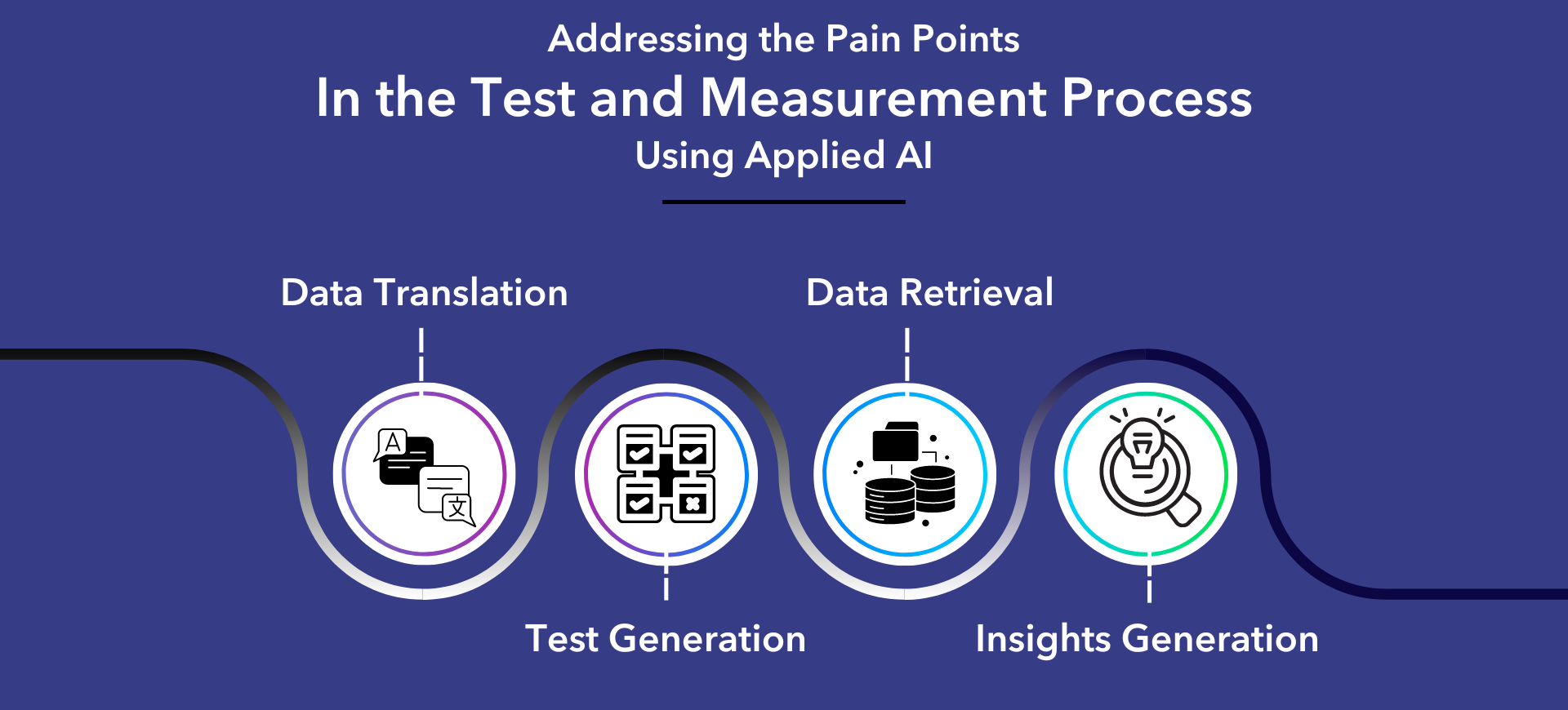The new wave of Artificial Intelligence (AI) has taken the world by storm. The emergence of novel versions and applications of generative AI like ChatGPT and other LLMs has piqued the interest of common people and the R&D teams of several industries. From healthcare and finance to cybersecurity and engineering, the scope of applying AI is almost endless and it offers the potential to be a significant differentiator in any field.
When delving deep into the use of AI in engineering, ‘Test and Measurement’ is one area where generative AI could help solve complex real-time problems and provide efficient solutions.
Addressing the Pain Points in the Test and Measurement Process
Test and measurement plays a vital role across product development & manufacturing lifecycles. Extensive testing of the device under test (DUT) across several conditions, validating several design parameters and then verifying the results remain one of the most intricate & involved processes in the entire lifecycle.
The testing process can be arduous as it involves dedicated manual effort, leading to increased testing time and, sometimes, inefficiencies with the results. Test Automation proved to be an effective alternative to manual testing to overcome these roadblocks in the test and measurement workflow. However, in specific scenarios, traditional automation software might fail, and logical programming might be rendered ineffective when reasoning is involved.
Under such circumstances, introduction of Applied AI can help expand the extent of automation involved manifold and deliver effective and quick results.

Here are some of the areas where the introduction of AI can significantly benefit the test and measurement process:
- Data Translation: The design verification & validation (V&V) process in any domain, be it Semiconductors, Medical Devices, or Automotive Systems, involves consolidating numerous requirements & design constraints and creating numerous test cases for these requirements. This can be a labour-intensive and time-consuming task that engineers often struggle with. Leveraging reasoning capabilities offered by LLMs, coupled with domain & device specific training, AI systems can be developed to even generate test case scenarios. Use of such AI systems can help guarantee compliant device testing, confirms comprehensive coverage, while ensuring quality.
- Test Generation: Taking the increasing quantity & complexity of tests into account, crafting test programs tailored to the test environment while meeting challenging product release timelines can be challenging. Adaptive testing is critical to an optimized testing strategy to address these challenges, and the use of generative AI to automate test creation, increasing the quality and incorporating the feedback into the test for a faster and more thorough analysis, can prove to be a game changer.
- Data Retrieval: Data in a semiconductor landscape can be humongous and distributed over multiple systems, and trying to decipher and interpret unstructured data can be quite overwhelming. In such scenarios, generative AI can extract the required data from large data pools, structured or unstructured, contextualize the distributed information and ensure faster responses answers depending on the user query.
- Insights Generation: Generative AI can also provide insights from the invisible data in the data pool, while providing expert recommendations through its knowledge retention. These instances can provide valuable insights into data forecasting, predictive maintenance, and anomaly detection.
Navigating the Challenge
With all the benefits generative AI offers in the test and automation space, and with data scientists and software engineers eager to explore its depth, a cascade of innovations and iterations of generative AI has emerged.
“What model should I use?” “What provider should I pick?” “Am I sufficiently addressing any data security risks?” “How do we start using this generative AI in real-time?” – these are frequent questions that pop up among users, often leading to dilemma and confusion from the user’s standpoint.
How Can Soliton Help?
Soliton aims to be an Applied AI Solutions Development partner for our customers. Amidst the availability of multiple models to choose from and relying on various technologies to solve problems, our highly customer-centric approach begins with identifying key customer pain points and then identifying the right the technology solution that effectively solves the problems. The solution is focused around solving their specific needs, thereby enabling us to deliver effective & tangible results.
Stay Tuned!
Integrating Applied AI in Test and Measurement engineering workflows signifies a transformative step toward solving real-time problems, contributing to enhanced efficiency and accuracy, resulting in a paradigm shift from conventional methods.
In our upcoming posts, we will delve deeper into how Soliton plans to leverage Applied AI to address complex challenges in the test & measurement domain.
Stay tuned for more insights, revelations, and solutions.